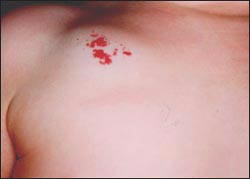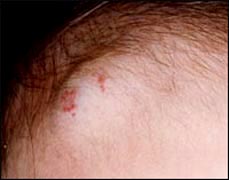해면상 혈관종, Cavernous hemangioma
해면상 혈관종의 개요

사진 496. 오른쪽 앞가슴 위 부위에 난 해면상 혈관종.
Copyrightⓒ 2012 John Sangwon Lee,MD., FAAP

사진 497. 이마에 난 해면상 혈관종.
Copyrightⓒ 2012 John Sangwon Lee,MD., FAAP
- 해면상 혈관종은 일종의 혈관성 낭종이다.
- 해면상 혈관종은 경계가 비교적 분명치 않고 암자색, 또는 붉은 색을 띤다.
- 크기와 모양이 다양하다
- 어떤 해면성 혈관종의 전체가 피부층의 바로 아래에 묻혀 있고 어떤 것은 일부는 피부층 표면 위로 현저히 솟아 나와서 딸기 혈관종처럼 나 있고, 나머지 부분은 피부층 바로 아래에 묻혀 있다. 이런 종류를 혼합형 해면상 혈관종이라고도 한다.
- 해면상 혈관종의 내 혈관 속에 피가 괴어 있는 것이 보통이다.
- 해면상 혈관종은 태어난 후 바로 나타날 수 있지만, 생후 2~3개월경에 더 선명하게 나타나기 시작한다.
- 해면상 혈관종 속 동맥과 정맥이 직접 연결되어 있을 수 있다.
- 큰 해면상 혈관종으로 혈소판이 비정상적으로 많이 파괴되어 혈소판 감소증이 생길 수 있다.
- 해면상 혈관종을 손으로 꼭 누르면 피부층 아래로 눌려 들어갈 수 있고, 좀 단단한 감이 있다. 해면상 혈관종의 바로 위의 피부색은 정상 피부색이거나 푸르스름한 색이거나 빨갛다.
- 대부분의 해면상 혈관종은 태어나서 생후 1~2세까지 점점 더 커지다가 그 후부터는 더 이상 커지지 않고 일정한 크기로 몇 년 정도 더 계속 있다가 전부 사라지는 자연과정을 밟는 것이 보통이다.
- 드물게 해면상 혈관종이 눈, 코, 귀 부위 등에 가까이 나서 그 기관의 기능 장애를 일으킬 수 있고 외관상으로 보기가 몹시 흉할 때도 있다.
해면상 혈관종의 치료
- 거의 대부분의 해면상 혈관종은 딸기 혈관종처럼 자연적으로 사라진다.
- 증상 징후, 크기, 합병증의 유무에 따라 치료해 준다.
- 안구나 콧구멍이나 귓구멍, 또는 입 등 중요한 기관을 막아 그의 기능을 가로 막는 해면상 혈관종은 프레드니손 등으로 치료한다.
- 혈소판 감소증이 생길 때는 혈소판 정맥주사로 즉시 치료한다.
- 그 정도와 합병증의 유무에 따라 수술, 방사선 치료, 또는 레이저 요법으로 치료한다.
- Hemangioma를 propanolol hydrochloride으로 치료할 수도 있다. 참조 문헌 Hemangioma, AAP News 11/2014.
Cavernous hemangioma
Overview of Cavernous Hemangiomas

Picture 496. Cavernous hemangioma in the upper right pronotum. Copyrightⓒ 2012 John Sangwon Lee, MD., FAAP

Picture 497. Cavernous hemangioma on the forehead. Copyrightⓒ 2012 John Sangwon Lee, MD., FAAP
• Cavernous hemangioma is a type of vascular cyst.
• Cavernous hemangiomas have relatively indistinct borders and are dark purple or reddish in color.
• Varies in size and shape
• Some cavernous hemangiomas are entirely buried just under the skin layer, some are prominently raised above the surface of the skin layer and look like strawberry hemangiomas, and others are buried just below the skin layer. This type is also called mixed cavernous hemangioma.
• It is common for cavernous hemangiomas to have blood in the blood vessels.
• Cavernous hemangioma can appear immediately after birth, but it begins to appear more clearly around 2-3 months of age.
• Arteries and veins in cavernous hemangiomas may be directly connected.
• It is a large cavernous hemangioma, which can cause thrombocytopenia due to abnormally high platelet destruction.
• If you press the cavernous hemangioma with your hands, it can be pressed under the skin layer, and it has a firm feel. The skin color just above the cavernous hemangioma is normal skin color, bluish, or red.
• Most cavernous hemangiomas grow larger from birth to 1 or 2 years of age, and after that, they do not grow any longer, remain constant for several years, and then go through a natural process that disappears altogether.
• Rarely, cavernous hemangiomas may come close to the eyes, nose, and ears, causing dysfunction of the organs, and are sometimes very unsightly.
Treatment of cavernous hemangioma
• Almost all cavernous hemangiomas disappear spontaneously, like strawberry hemangiomas.
• Treatment is given according to symptom signs, size, and presence or absence of complications.
• Cavernous hemangiomas that block the function of important organs such as the eyes, nostrils, ear canals, or mouth are treated with prednisone, etc
. • If thrombocytopenia develops, treat immediately with intravenous platelet injection.
• Depending on the severity and the presence of complications, it is treated with surgery, radiation therapy, or laser therapy.
• Hemangioma may be treated with propanolol hydrochloride. References Hemangioma, AAP News 11/2014.
출처 및 참조 문헌 Sources and references
- NelsonTextbook of Pediatrics 22ND Ed
- The Harriet Lane Handbook 22ND Ed
- Growth and development of the children
- Red Book 32nd Ed 2021-2024
- Neonatal Resuscitation, American Academy of Pediatrics
- www.drleepediatrics.com 제1권 소아청소년 응급 의료
- www.drleepediatrics.com 제2권 소아청소년 예방
- www.drleepediatrics.com 제3권 소아청소년 성장 발육 육아
- www.drleepediatrics.com 제4권 모유,모유수유, 이유
- www.drleepediatrics.com 제5권 인공영양, 우유, 이유식, 비타민, 미네랄, 단백질, 탄수화물, 지방
- www.drleepediatrics.com 제6권 신생아 성장 발육 육아 질병
- www.drleepediatrics.com제7권 소아청소년 감염병
- www.drleepediatrics.com제8권 소아청소년 호흡기 질환
- www.drleepediatrics.com제9권 소아청소년 소화기 질환
- www.drleepediatrics.com제10권. 소아청소년 신장 비뇨 생식기 질환
- www.drleepediatrics.com제11권. 소아청소년 심장 혈관계 질환
- www.drleepediatrics.com제12권. 소아청소년 신경 정신 질환, 행동 수면 문제
- www.drleepediatrics.com제13권. 소아청소년 혈액, 림프, 종양 질환
- www.drleepediatrics.com제14권. 소아청소년 내분비, 유전, 염색체, 대사, 희귀병
- www.drleepediatrics.com제15권. 소아청소년 알레르기, 자가 면역질환
- www.drleepediatrics.com제16권. 소아청소년 정형외과 질환
- www.drleepediatrics.com제17권. 소아청소년 피부 질환
- www.drleepediatrics.com제18권. 소아청소년 이비인후(귀 코 인두 후두) 질환
- www.drleepediatrics.com제19권. 소아청소년 안과 (눈)질환
- www.drleepediatrics.com 제20권 소아청소년 이 (치아)질환
- www.drleepediatrics.com 제21권 소아청소년 가정 학교 간호
- www.drleepediatrics.com 제22권 아들 딸 이렇게 사랑해 키우세요
- www.drleepediatrics.com 제23권 사춘기 아이들의 성장 발육 질병
- www.drleepediatrics.com 제24권 소아청소년 성교육
- www.drleepediatrics.com 제25권 임신, 분만, 출산, 신생아 돌보기
- Red book 29th-31st edition 2021
- Nelson Text Book of Pediatrics 19th- 21st Edition
- The Johns Hopkins Hospital, The Harriet Lane Handbook, 22nd edition
- 응급환자관리 정담미디어
- Pediatric Nutritional Handbook American Academy of Pediatrics
- 소아가정간호백과–부모도 반의사가 되어야 한다, 이상원 저
- The pregnancy Bible. By Joan stone, MD. Keith Eddleman, MD
- Neonatology Jeffrey J. Pomerance, C. Joan Richardson
- Preparation for Birth. Beverly Savage and Dianna Smith
- 임신에서 신생아 돌보기까지. 이상원
- Breastfeeding. by Ruth Lawrence and Robert Lawrence
- Sources and references on Growth, Development, Cares, and Diseases of Newborn Infants
- Emergency Medical Service for Children, By Ross Lab. May 1989. p.10
- Emergency care, Harvey Grant and Robert Murray
- Emergency Care Transportation of Sick and Injured American Academy of Orthopaedic Surgeons
- Emergency Pediatrics A Guide to Ambulatory Care, Roger M. Barkin, Peter Rosen
- Quick Reference To Pediatric Emergencies, Delmer J. Pascoe, M.D., Moses Grossman, M.D. with 26 contributors
- Neonatal resuscitation Ameican academy of pediatrics
- Pediatric Nutritional Handbook American Academy of Pediatrics
- Pediatric Resuscitation Pediatric Clinics of North America, Stephen M. Schexnayder, M.D.
-
Pediatric Critical Care, Pediatric Clinics of North America, James P. Orlowski, M.D.
-
Preparation for Birth. Beverly Savage and Dianna Smith
-
Infectious disease of children, Saul Krugman, Samuel L Katz, Ann A.
- 제4권 모유, 모유수유, 이유 참조문헌 및 출처
- 제5권 인공영양, 우유, 이유, 비타민, 단백질, 지방 탄수 화물 참조문헌 및 출처
- 제6권 신생아 성장발육 양호 질병 참조문헌 및 출처
- 소아과학 대한교과서
Copyright ⓒ 2014 John Sangwon Lee, MD., FAAP
“부모도 반의사가 되어야 한다”-내용은 여러분들의 의사로부터 얻은 정보와 진료를 대신할 수 없습니다.
“The information contained in this publication should not be used as a substitute for the medical care and advice of your doctor. There may be variations in treatment that your doctor may recommend based on individual facts and circumstances.
“Parental education is the best medicine.